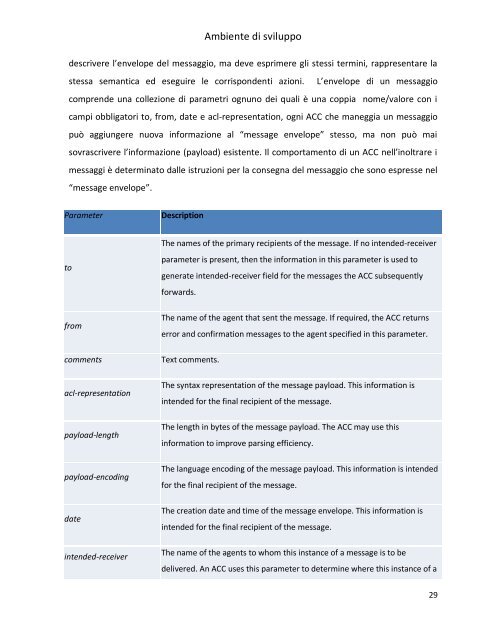Facoltà di Ingegneria Corso di Laurea Magistrale in Ingegneria ...
Facoltà di Ingegneria Corso di Laurea Magistrale in Ingegneria ...
Facoltà di Ingegneria Corso di Laurea Magistrale in Ingegneria ...
Create successful ePaper yourself
Turn your PDF publications into a flip-book with our unique Google optimized e-Paper software.
Ambiente <strong>di</strong> sviluppo<br />
descrivere l’envelope del messaggio, ma deve esprimere gli stessi term<strong>in</strong>i, rappresentare la<br />
stessa semantica ed eseguire le corrispondenti azioni. L’envelope <strong>di</strong> un messaggio<br />
comprende una collezione <strong>di</strong> parametri ognuno dei quali è una coppia nome/valore con i<br />
campi obbligatori to, from, date e acl-representation, ogni ACC che maneggia un messaggio<br />
può aggiungere nuova <strong>in</strong>formazione al “message envelope” stesso, ma non può mai<br />
sovrascrivere l’<strong>in</strong>formazione (payload) esistente. Il comportamento <strong>di</strong> un ACC nell’<strong>in</strong>oltrare i<br />
messaggi è determ<strong>in</strong>ato dalle istruzioni per la consegna del messaggio che sono espresse nel<br />
“message envelope”.<br />
Parameter Description<br />
to<br />
from<br />
The names of the primary recipients of the message. If no <strong>in</strong>tended-receiver<br />
parameter is present, then the <strong>in</strong>formation <strong>in</strong> this parameter is used to<br />
generate <strong>in</strong>tended-receiver field for the messages the ACC subsequently<br />
forwards.<br />
comments Text comments.<br />
acl-representation<br />
payload-length<br />
payload-enco<strong>di</strong>ng<br />
date<br />
<strong>in</strong>tended-receiver<br />
The name of the agent that sent the message. If required, the ACC returns<br />
error and confirmation messages to the agent specified <strong>in</strong> this parameter.<br />
The syntax representation of the message payload. This <strong>in</strong>formation is<br />
<strong>in</strong>tended for the f<strong>in</strong>al recipient of the message.<br />
The length <strong>in</strong> bytes of the message payload. The ACC may use this<br />
<strong>in</strong>formation to improve pars<strong>in</strong>g efficiency.<br />
The language enco<strong>di</strong>ng of the message payload. This <strong>in</strong>formation is <strong>in</strong>tended<br />
for the f<strong>in</strong>al recipient of the message.<br />
The creation date and time of the message envelope. This <strong>in</strong>formation is<br />
<strong>in</strong>tended for the f<strong>in</strong>al recipient of the message.<br />
The name of the agents to whom this <strong>in</strong>stance of a message is to be<br />
delivered. An ACC uses this parameter to determ<strong>in</strong>e where this <strong>in</strong>stance of a<br />
29



